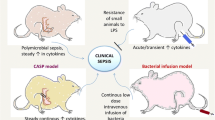Abstract
Mice are a suitable animal model for sepsis studies because they recapitulate many aspects of the pathophysiology observed in septic human patients. It is ethically preferable to use mice for research over higher sentient species, when scientifically appropriate. Mice are also advantageous for research due to their small size, modest housing needs, the availability of genetically modified strains, and the broad range of reagents available for scientific assays on this species. Nevertheless, there are some intrinsic differences between mice and humans that should be recognized when considering the translational potential of sepsis therapies. It is often wise to complement traditional mouse studies with animal models that exhibit even greater similarity to humans, and in particular, models that better recapitulate the human immune response. Humanized mice are a promising tool to bridge this interspecies research gap. Herein, we provide a protocol to generate BLT humanized mice and describe their sepsis phenotype after cecal ligation and puncture (CLP).
Access this chapter
Tax calculation will be finalised at checkout
Purchases are for personal use only
Similar content being viewed by others
References
Lagu T, Rothberg MB, Shieh MS et al (2012) Hospitalizations, costs, and outcomes of severe sepsis in the United States 2003 to 2007. Crit Care Med 40:754–761
Angus DC, Linde-Zwirble WT, Lidicker J et al (2001) Epidemiology of severe sepsis in the United States: analysis of incidence, outcome, and associated costs of care. Crit Care Med 29:1303–1310
Takao K, Miyakawa T (2015) Genomic responses in mouse models greatly mimic human inflammatory diseases. Proc Natl Acad Sci U S A 112:1167–1172
Seok J, Warren HS, Cuenca AG et al (2013) Genomic responses in mouse models poorly mimic human inflammatory diseases. Proc Natl Acad Sci U S A 110:3507–3512
Osuchowski MF, Remick DG, Lederer JA et al (2014) Abandon the mouse research ship? Not just yet! Shock 41:463–475
Remick D (2013) Use of animal models for the study of human disease-a shock society debate. Shock 40:345–346
Smith DJ, Lin LJ, Moon H et al (2016) Propagating humanized BLT mice for the study of human immunology and immunotherapy. Stem Cells Dev 25:1863–1873
Melkus MW, Estes JD, Padgett-Thomas A et al (2006) Humanized mice mount specific adaptive and innate immune responses to EBV and TSST-1. Nat Med 12:1316–1322
Lan P, Tonomura N, Shimizu A et al (2006) Reconstitution of a functional human immune system in immunodeficient mice through combined human fetal thymus/liver and CD34+ cell transplantation. Blood 108:487–492
Ye C, Choi JG, Abraham S et al (2012) Human macrophage and dendritic cell-specific silencing of high-mobility group protein B1 ameliorates sepsis in a humanized mouse model. Proc Natl Acad Sci U S A 109:21052–21057
Unsinger J, McDonough JS, Shultz LD et al (2009) Sepsis-induced human lymphocyte apoptosis and cytokine production in “humanized” mice. J Leukoc Biol 86:219–227
Skirecki T, Kawiak J, Machaj E et al (2015) Early severe impairment of hematopoietic stem and progenitor cells from the bone marrow caused by CLP sepsis and endotoxemia in a humanized mice model. Stem Cell Res Ther 6:142
Skirecki T, Drechsler S, Hoser G et al (2019) The fluctuations of leukocytes and circulating cytokines in septic humanized mice vary with outcome. Front Immunol 10:1427
Lapko N, Zawadka M, Polosak J et al (2017) Long-term monocyte dysfunction after sepsis in humanized mice is related to persisted activation of macrophage-colony stimulation factor (M-CSF) and demethylation of PU. 1, and it can be reversed by blocking M-CSF in vitro or by transplanting naive autologous stem cells in vivo. Front Immunol 8:401
Laudanski K, Lapko N, Zawadka M et al (2017) The clinical and immunological performance of 28 days survival model of cecal ligation and puncture in humanized mice. PLoS One 12:e0180377
Walker WE (2018) Methods to study the innate immune response to sepsis. Methods Mol Biol 1717:189–206
Goswami DG, Garcia LF, Dodoo C et al (2021) Evaluating the timeliness and specificity of CD69, CD64 and CD25 as biomarkers of sepsis in MICE. Shock 55:507–518
Walker WE, Bozzi AT, Goldstein DR (2012) IRF3 contributes to sepsis pathogenesis in the mouse cecal ligation and puncture model. J Leukoc Biol 92:1261–1268
Heipertz EL, Harper J, Walker WE (2017) STING and TRIF contribute to mouse sepsis, depending on severity of the disease model. Shock 47:621–631
Heipertz EL, Harper J, Lopez CA et al (2018) Circadian rhythms influence the severity of sepsis in mice via a TLR2-dependent, leukocyte-intrinsic mechanism. J Immunol 201(1):193–201
Notta F, Doulatov S, Dick JE (2010) Engraftment of human hematopoietic stem cells is more efficient in female NOD/SCID/IL-2Rgc-null recipients. Blood, the journal of the American society of. Hematology 115:3704–3707
Acknowledgments
This work was supported by a seed grant from TTUHSC El Paso. We would like to thank Dinesh Goswami and Blake Mireles for assistance with photography.
Author information
Authors and Affiliations
Corresponding author
Editor information
Editors and Affiliations
Rights and permissions
Copyright information
© 2021 Springer Science+Business Media, LLC, part of Springer Nature
About this protocol
Cite this protocol
Heipertz, E.L., Walker, W.E. (2021). Creation of BLT Humanized Mice for Sepsis Studies. In: Walker, W.E. (eds) Sepsis. Methods in Molecular Biology, vol 2321. Humana, New York, NY. https://doi.org/10.1007/978-1-0716-1488-4_12
Download citation
DOI: https://doi.org/10.1007/978-1-0716-1488-4_12
Published:
Publisher Name: Humana, New York, NY
Print ISBN: 978-1-0716-1487-7
Online ISBN: 978-1-0716-1488-4
eBook Packages: Springer Protocols




